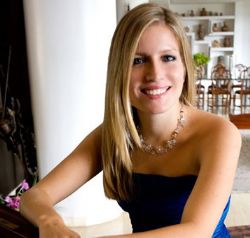|
Symphony
FROM THE NEW WORLD TO THE OLD WORLD
by Peter Lert
Saturday, June 14, 2025
Chamber
MC2 DUO RECITAL CLOSES 222'S SEASON
by Terry McNeill
Saturday, June 14, 2025
Choral and Vocal
CANTIAMO SONOMA'S LUSCIOUS A CAPELLA SINGING IN SEASON ENDING CONCERT
by Pamela Hicks Gailey
Sunday, June 8, 2025
Symphony
SRS SEASON ENDS WITH RESOUNDING TA-TA-TA-BANG
by Terry McNeill
Sunday, June 1, 2025
Symphony
YOUTHFUL VIRTUOSITY ON DISPLAY AT USO'S MAY CONCERTS
by Peter Lert
Saturday, May 17, 2025
Symphony
MYSTICAL PLANETS AND LIVELY GERSHWIN ORTIZ AT FINAL SRS CONCERT
by Peter Lert
Sunday, May 4, 2025
Symphony
VSO'S CONCERT MUSIC OF TIME, MUSIC OF PLACE
by Peter Lert
Sunday, April 27, 2025
VOCAL ELEGANCE AND FIRE AT THE 222'S RECITAL APRIL 26
by Pamela Hicks Gailey
Saturday, April 26, 2025
CANTIAMO SONOMA SINGS AN INSPIRED GOOD FRIDAY MOZART REQUIEM CONCERT
by Pamela Hicks Gailey
Friday, April 18, 2025
DRAMATIC SHOSTAKOVICH SYMPHONY CLOSES PHILHARMONIC'S 25TH SEASON
by Terry McNeill
Sunday, April 13, 2025
|
 |
 Pianist Gabriela Martinez |
A SOUND TO BEHOLD
by Steve Osborn
Saturday, May 7, 2016
Concert titles are rarely specific, but the one for the Santa Rosa Symphony’s May 7 concert, “Jazzy Impressions,” is as literal as they get. The first half consisted of two American pieces influenced by jazz, and the second of two French works in the impressionist style.
Pairing two similar pieces in a concert is risky, because one inevitably suffers in comparison with the other. In this case, Gershwin’s piano concerto easily trumped Bernstein’s dance music from “On the Town,” and Ravel’s “Rapsodie espagnole” edged out Debussy’s “Ibéria.”
The main reason for Gershwin’s success is the piano part, which was brilliantly played by the Venezuelan Gabriela Martinez. Eschewing flash and glitz, she sat upright at the piano, playing with confidence and poise rather than excessive drama. Her arms were as elegant as a ballerina’s, and she consistently raised one or both in the air at the end of phrases and difficult passages, sometimes even bringing them behind her back.
Martinez’s articulations were precise, with nary a missed note, and her projection was admirable. No amount of projection, however, could overcome the orchestra, which often played too loudly, particularly in the first movement. Something is not right when the pianist is playing all out but can’t be heard above her accompaniment.
Gershwin’s music in the concerto is at times inspired, but it often drifts aimlessly, as in the second movement, where the many orchestral solos leave the pianist sitting mute for dozens of measures at a time. The high point, for both Gershwin and the players, comes in the third movement, with its fiery beginning and meaty lines. Martinez finally had something to sink her teeth into, and she performed flawlessly. Her accented syncopations were superb, and she gave the movement a dramatic arch that was sustained until the last measure.
The opening Bernstein dances were well played, with standout solos by Doug Morton (trumpet), Roy Zajac (clarinet) and Mark Wardlaw (alto sax). Originally intended for a Broadway pit orchestra, the music suffers from the transition to a concert hall. It’s incongruous to see a tuxedoed percussionist playing off a score while seated at a jazz/rock drum set in the middle of the orchestra. Just because it sounds good on Broadway doesn’t mean it’s ready for Carnegie Hall.
The Debussy and Ravel pieces in the second half were not only cast from the same impressionist mold, they also tackled the same subject: Spain. The pairing led to a certain amount of department of redundancy department experience, with a faintly academic tinge. Nonetheless, there was enough difference to sustain interest.
Debussy’s “Iberia” might be more properly titled “Debusseria,” for all the resemblance it bears to Spain. Debussy spent only one afternoon of his life in Spain--and that at a bullfight--so the piece is more his imagination of what Spain sounds like than the actually reality of Spain.
Regardless of the music’s program, the result is pure Debussy, with a constant subsurface tension that spills over at dramatic moments. Conductor Bruno Ferrandis used liquescent gestures to coax forth the dreamy sound, creating an atmosphere of mystery. Most haunting were the bells in the “Spanish night” movement. The tension kept building through the next, “Spanish festival,” until a triumphant arrival in the final bars. The playing was impeccable.
Ravel’s “Rapsodie espagnole” was truer to Spain and more daring in its structures. The descending four-note half-scales at the beginning of the opening movement (Prelude to the night) set the stage for extended flights of musical fancy. As in Debussy, the atmosphere is always expectant, always about to explode. Ferrandis heightened this tension with carefully controlled dynamics, by turns hushing the orchestra and letting it loose.
The dances of the middle movements (Malagueña and Habanera) were played with a strong feeling for the syncopations and the rhythmic sway. The fireworks came in the last movement, thanks to Ravel’s magnificent orchestration and fine playing from every corner of the orchestra. Each layer of notes was audible in Weill Hall’s wonderful acoustics, and the tremendous crescendo at the end was a sound to behold.
|
